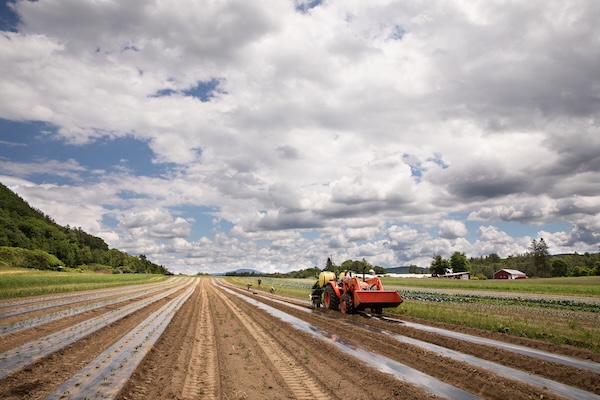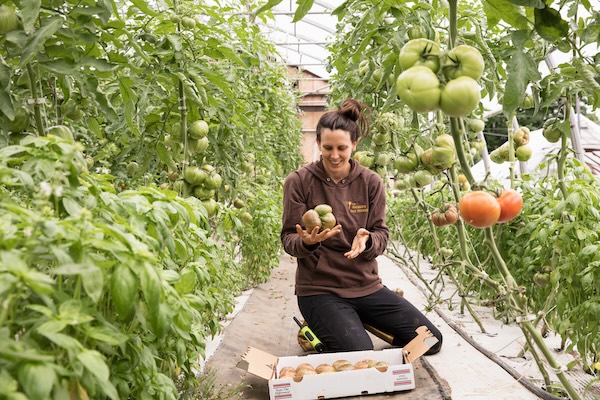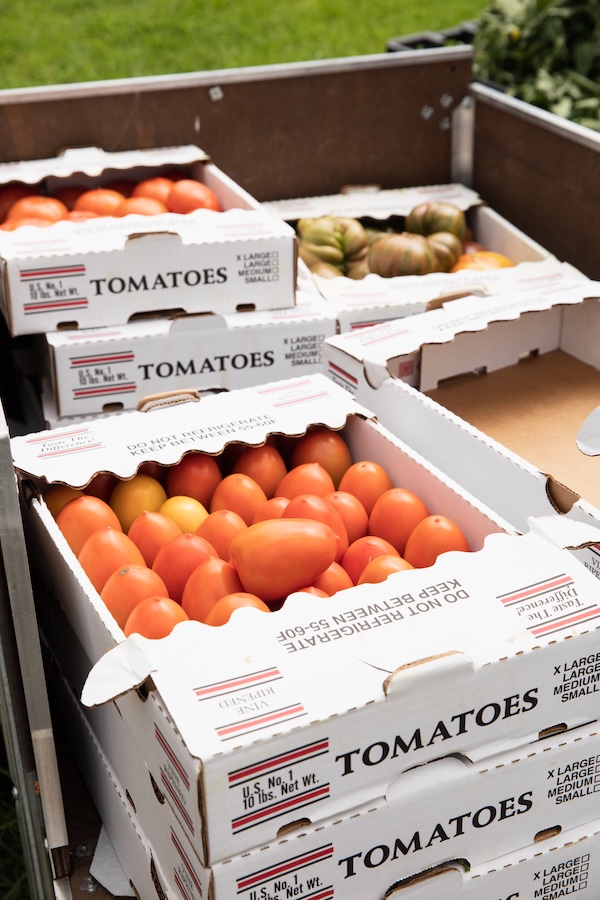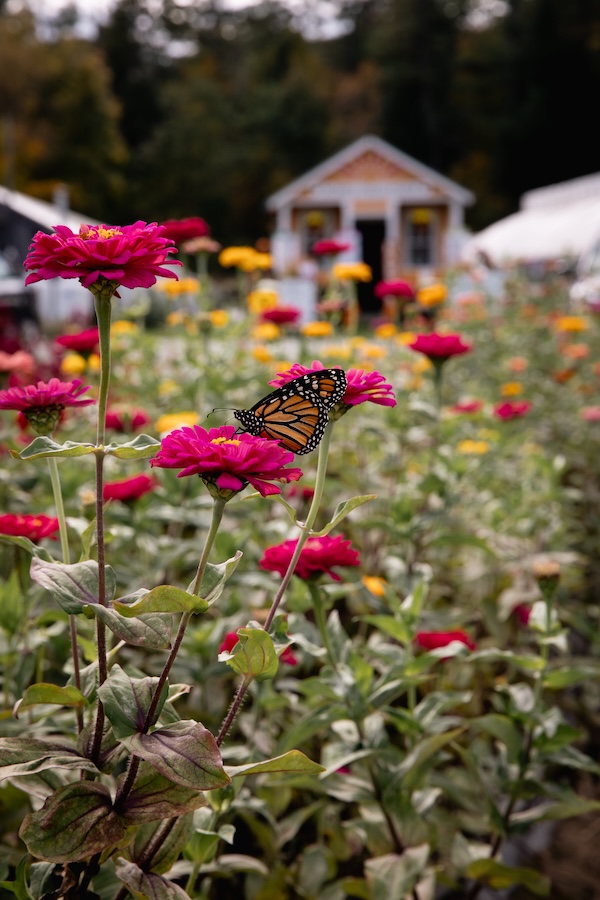By Jennifer Wilhelm
Building community is something farmers Valerie Woodhouse and Eli Hersh of Honey Field Farm in Norwich, Vermont, take seriously. From hosting engaging onsite events to creating a supportive work environment for their farm crew, making their farm a place where people gather to celebrate organic growing is a top priority. And a strong community of support is a necessity when scaling up from 2 acres and no employees to running a 12-acre certified organic farm with 11 greenhouses and 20 employees.

Honey Field Farm, situated on a wide bend in the Connecticut River, is an old farm with new owners. Woodhouse and Hersh took over the site of Killdeer Farm, a well-known and loved greenhouse operation with a dedicated force of customers who had been shopping at the farm for decades. This foundation of committed customers made the prospect of scaling up feasible.
“We were fortunate to inherit an incredible customer base at the greenhouses from May through July, a much bigger volume than we could have built from scratch,” says Hersh. “Our community is remarkably supportive of local agriculture, and in our first year we drummed up over 70 CSA members as new kids on the crowded block.”
Continuing to grow that base by hosting events at the farm has been key to helping them meet their considerable financial investment. Since their first year in operation, they offered educational workshops, opened the farm for tours, and kicked off “Pepper Fest,” an annual event that places the sometimes sweet, sometimes spicy pepper center stage. From 45-plus varieties of pick-your-own peppers in the market garden, to tastings and eating challenges, to games and making fruit art, Pepper Fest brings crowds to the farm. Agritourism events such as this help to not only expand Honey Field Farm’s markets but to also raise awareness about local farming.
As a first-generation farmer, Hersh had his own learning journey about farming. He began as a farm apprentice on the West Coast in 2009. Over the course of 11 years, he worked on nine different farms, advancing from farm apprentice to manager, and learning as many new skills as possible that would help him run a successful farm business, including how to operate and maintain a tractor, install fencing, and repair plumbing.
Woodhouse’s farming experience began in childhood on family homesteads and ranches in Lancaster, Pennsylvania. While she thought she might prefer city life, she soon enough found herself volunteering in an urban garden in Philadelphia and was reminded of her deep agricultural roots. After moving to Vermont to work on her aunt’s farm, she fell in love with the area and dug deeper into learning about vegetable production.

When Hersh and Woodhouse met in 2012, they quickly learned of their common passion for farming, having one of their first dates harvesting cabbage. From there, they continued to work on farms in Vermont, dreaming and scheming plans for how they could transition from working on someone else’s farm to owning and operating their own.
“We wrote a business plan and formal proposal for the owner of the farm we worked at, River Berry Farm, asking him to lease a couple acres and access to his infrastructure and equipment for +/-5 years so we could get our business off the ground,” says Hersh. “In return, I would commit to working as his field manager for those years, and run my operation in my free time. The idea of this was to build up business momentum that was oversized for our 2-acre part-time operation, and use it as leverage to launch ourselves onto a larger property where we would farm full-time.”
Once they had proof of concept, they began to prepare in earnest for the transition. They spent hours doing research and developing projections for cash flow to understand realistically what their expenses and revenue would be. They worked with technical assistance providers to navigate all of the resources available to them and to develop a solid business plan. To find available farmland, they worked with state land trusts and agricultural service providers. Hersh and Woodhouse applied for grants to help fund various aspects of their operation. Once they found the property that matched their business needs, they worked with Dirt Capital Partners to purchase the farm through a lease-to-own agreement.
In addition to this agreement, Woodhouse and Hersh opened a line of credit through Farm Credit East, and secured a loan through Vermont Farm Fund, which allowed them to acquire the equipment necessary for their first season.

“We knew it was a big gamble and would inevitably be chaotic for several years, but that by the 10-year mark we’d end up way ahead of our original goals,” says Woodhouse.
Since 2019, they have applied for and received a number of grants to offset the cost of equipment and renovations. The Vermont Agency of Agriculture, Food and Markets has funded many of these grants, which made it possible for Woodhouse and Hersh to construct a walk-in cooler and purchase a delivery vehicle, an ice machine, and a barrel washer for washing root vegetables. They are currently in the process of renovating their barn to update their farm’s wash-pack process: a big undertaking that would not have been possible without the support of these farm business grants.
Today, at Honey Field Farm, Woodhouse and Hersh have 12 acres and three greenhouses of organic vegetables in production. They also manage eight greenhouses of seedlings for live plant sales, including annual and perennial flowers, as well as organic vegetables and herbs. Additionally, they grow a variety of cut flowers.

Their markets are diverse, with the majority of vegetable production going to wholesale accounts with local grocers, value-added producers, and regional distributors. They also have a large direct-to-consumer channel through community supported agriculture (CSA) shares, farmers’ markets, and their own farm store. Their tens of thousands of live plants are also sold direct-to-consumer, with increasing wholesale to local nurseries and other stores for resale.
After five years in business, while there is still uncertainty in the long-term financial sustainability of their farm operation, the momentum Woodhouse and Hersh have built over the years has put them on the right path.
“Now our focus shifts to streamlining and removing unnecessary costs while maintaining our level of sales and production so that our bottom line will improve over time,” says Woodhouse.
In the meantime, Woodhouse and Hersh put in the time (too many long days to count) and continue to learn new skills, such as how to develop a new five-year business plan that incorporates a healthier work-life balance.
To new farmers, they say, “Try to think realistically about the investments needed in terms of both cash and also hours of work, and if you are in a place where you can weather the financial instability. Be clear with yourself about what trajectory you are on and what the long-term goals are to help you get through the growing pains.”
This article was originally published in the summer 2025 issue of The Maine Organic Farmer & Gardener.